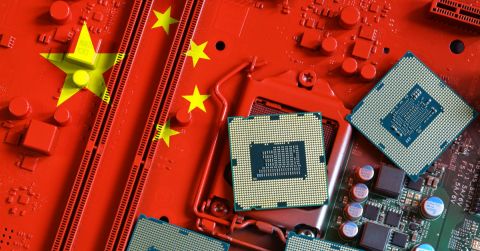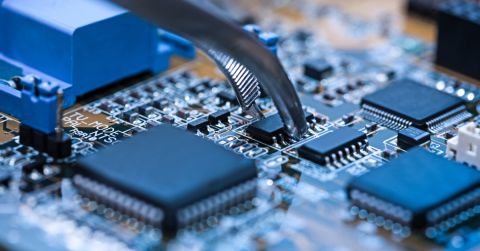10 Leading Components for Edge Computing

Key Takeaways
- Edge computing is reshaping how hardware is designed, built, and deployed. By processing data locally, edge devices deliver faster insights, reduce cloud dependence, and strengthen data privacy.
- To meet these demands, modern components now integrate AI acceleration, extreme energy efficiency, secure (and sometimes redundant) connectivity, and extended lifecycle support.
- The following list highlights ten proven parts that embody these capabilities, components engineers can trust to anchor the next generation of edge deployments.
Leading Parts Powering the Edge
Hardware innovation is driving the edge revolution. Each new generation of devices must combine AI intelligence, energy efficiency, ruggedness, and secure connectivity within tighter size, power, and cost limits.
The ten components below represent leading solutions already shaping real-world deployments. From ultra-efficient AI accelerators to full-featured system-on-modules, they demonstrate how today’s silicon is evolving to meet tomorrow’s edge requirements.
1. NVIDIA Jetson AGX Orin
This high-end AI system-on-module delivers up to 275 TOPS in a scalable 15-60 W power envelope. Built on NVIDIA's Ampere GPU architecture with 2048 CUDA cores, 64 Tensor cores, and a 12-core Arm Cortex-A78AE CPU, the NVIDIA Jetson AGX Orin includes comprehensive development tools through JetPack SDK and NVIDIA NGC. Ideal for generative AI, robotics, autonomous vehicles, and industrial applications.
2. Google Coral Dev Board Micro
Google’s Coral Dev Board Micro board combines an NXP i.MX RT1176 MCU (featuring both Cortex-M7 and Cortex-M4 processors) with a 4 TOPS Edge TPU coprocessor delivering 2 TOPS per watt efficiency. Built-in sensors include a Himax color camera (324 x 324 px) and PDM mono microphone, supporting rapid prototyping of low-power embedded systems with on-device ML inferencing.
This board is well-suited for edge AI applications that require ultra-low power consumption and scalable processing capabilities. Equipped with a 4 TOPS Edge TPU and efficient under ~3 W of power, this compact single-board computer accelerates rapid prototyping of AI-powered vision and IoT applications. It supports TensorFlow Lite models and pre-built models, making it great for R&D and proof-of-concept projects.
3. Intel Neural Compute Stick 2
As a USB plug-in accelerator based on the Intel Movidius Myriad X VPU delivering >1 TOPS performance, the Neural Compute Stick 2 (NCS-2) is a great solution for retrofitting AI inference into existing systems with minimal effort. The NCS-2 provides 8X the performance of its predecessor and comes with Intel's OpenVINO toolkit for cross-platform deployment, supporting both convolutional neural networks (CNNs) and complex neural architectures.
4. AMD/Xilinx Kria K24 SOM
The AMD/Xilinx KriaTM K24 is a cost-optimized SOM that features a custom Zynq UltraScale+ MPSoC in a compact form factor about half the size of a credit card. Designed for DSP applications, it delivers 2X latency advantages over standard SoCs for single-axis drives, scaling to 7X for multi-axis systems.
With pre-built Vitis motor control libraries and support for Python and MATLAB Simulink, it's a solid choice for industrial motor control, medical equipment, sensor fusion, and factory automation requiring power-efficient, deterministic performance.
5. Qualcomm Robotics RB6 Platform
The Qualcomm RB6 Robotics Platform delivers 70–200 TOPS through an enhanced AI Engine with Hexagon DSP, combined with the QRB5165 SoC featuring Kryo 585 CPUs and Adreno 650 GPU. Supporting 24 concurrent camera feeds and global 5G connectivity via modular expansion cards, it targets autonomous mobile robots, delivery systems, and urban air mobility.
The comprehensive Intelligent Multimedia SDK provides end-to-end development tools for advanced robotics applications.
6. Hailo-8 AI Accelerator (M.2)
This compact M.2 module delivers 26 TOPS through the Hailo-8 AI processor with best-in-class power efficiency. Available in multiple form factors, including Key M (22 x 42mm with breakable extensions), Key B+M, and Key A+E variants, it features PCIe Gen 3.0 interfaces with 2-lane or 4-lane configurations.
Supporting extended temperature ranges from -40°C to 85°C, the Hailo-8 AI Accelerator (M.2) enables real-time, low-latency AI inferencing with scalable multi-stream and multi-model processing. The comprehensive Dataflow Compiler supports TensorFlow, TensorFlow Lite, ONNX, Keras, and PyTorch frameworks, enabling rapid deployment of neural network models across diverse edge applications.
7. Rockchip RK3576 AIoT Processor
The low-power Rockchip RK3576 AIoT processor combines quad Cortex-A72 and quad Cortex-A53 cores with a 6 TOPS NPU supporting multiple data types, including INT4/INT8/INT16/FP16. The integrated 16-megapixel ISP supports triple MIPI CSI-2 interfaces, while the Mali-G52 MC3 GPU provides Vulkan 1.2 graphics acceleration.
Features include 4K at 120fps H.265/VP9/AV1 decoding, dual 4K encoding, and multiple simultaneous display outputs. With PCIe 2.1, USB 3.0, dual CAN FD, and LPDDR5 support, it targets intelligent cabin systems, ARM PCs, robotics, and industrial applications.
8. NXP i.MX 8M Plus
Featuring quad or dual-core ARM® Cortex-A53 processors running at 1.8 GHz, a Cortex-M7 real-time core at 800 MHz, and a 2.3 TOPS NPU, the NXP i.MX 8M Plus strikes a strong balance between general-purpose computing and embedded AI.
It supports dual image signal processors (ISPs) with two camera inputs and offers industrial-grade reliability, featuring DRAM inline ECC. This makes it an excellent solution for long-lifecycle IoT, HMI, and factory floor applications that require machine learning and vision capabilities.
9. Axelera Metis AI Platform
Delivering a staggering 214 TOPS at 15 TOPS/W through an innovative Digital-In-Memory Computing (D-IMC) architecture, the Axelera Metis AI platform is built for high-throughput vision analytics, smart camera systems, and video-heavy edge environments.
With quad AI cores that can process up to 3,200 FPS on ResNet-50 while consuming just ~10–12W typical power, it reduces data movement and packs massive efficiency into a compact module available in M.2, PCIe, and compute board form factors.
10. SiMa.ai MLSoC (Modalix)
SiMa.ai’s MLSoC modules can deliver 50 TOPS at just 8–10 W, yielding a top-tier efficiency of ~10 TOPS/W. Built for multimodal edge applications, the Modalix family integrates text, image, audio, and video inputs to run everything from CNNs and Transformers to LLMs and GenAI on a single chip. With an integrated eight-core ARM Cortex-A65 processor and the Palette SDK, it can run models like Llama 2-7B directly on-device while maintaining exceptional energy efficiency.
For a deep dive into the forces driving these edge innovations, see 6 Edge Computing Trends Shaping Hardware Decisions.
Sourcing Tips for Your BOM
- Use Octopart for a comprehensive view of part availability, pricing trends, and lifecycle status for key modules, such as the Jetson AGX Orin.
- Track pricing, availability, and drop-shipping via your preferred distributor using Octopart. This is particularly helpful with less commonly stocked components, such as Hailo-8, Kria SOM, or Axelera modules.
- Always evaluate key reliability factors, such as temperature ratings, support longevity, and supply-chain risk, especially for industrial or defense-grade deployments. For AI accelerators, verify framework and toolchain compatibility early to prevent costly rework down the line.
- Consider lead times for AI modules, which can range from several weeks to several months, especially for newer products that are still ramping up production.
- Evaluate minimum order quantities (MOQs). Some specialized AI accelerators may have higher MOQs that impact prototyping budgets.
- Check power delivery requirements early. Some high-performance modules require specific voltage rails or power sequencing, which may necessitate BOM changes.
Putting Edge Trends into Practice
There’s no universal blueprint for edge computing. Every deployment has unique demands, from real-time vision and extreme power efficiency to industrial durability and software compatibility. The key is aligning performance, resilience, and availability with your specific application.
The ten components featured here illustrate the direction of edge innovation, yet careful component validation for your design remains essential. Always confirm specifications, supplier stability, and lifecycle data before committing to production. With Octopart, engineers and procurement teams can compare, track, and source parts confidently, building edge systems that last beyond the next design cycle.









